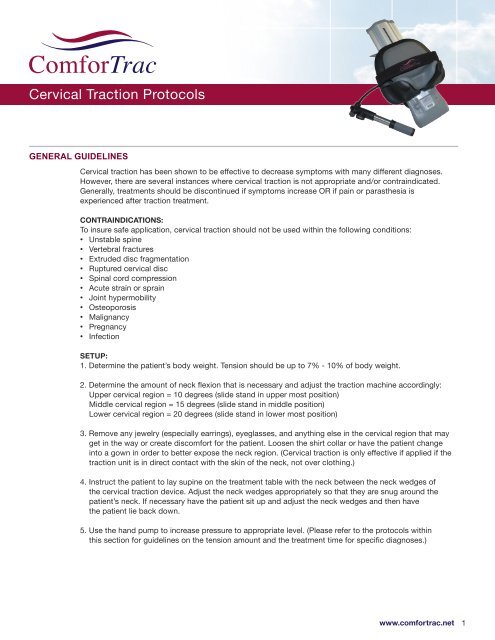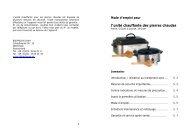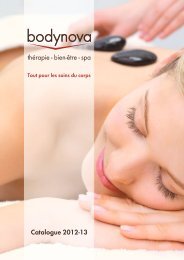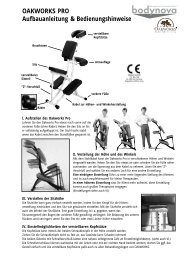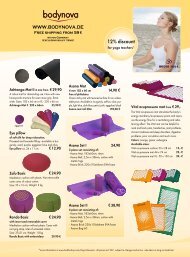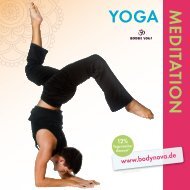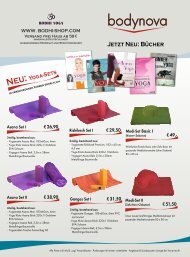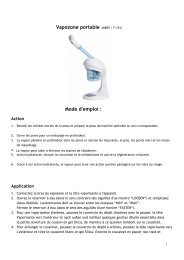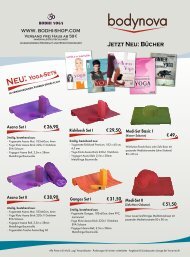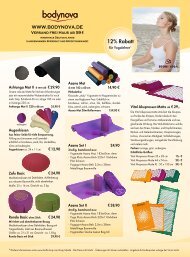ComforTrac Detailed user instruction for Cervical Home Traction ...
ComforTrac Detailed user instruction for Cervical Home Traction ...
ComforTrac Detailed user instruction for Cervical Home Traction ...
Create successful ePaper yourself
Turn your PDF publications into a flip-book with our unique Google optimized e-Paper software.
<strong>Com<strong>for</strong>Trac</strong><br />
<strong>Cervical</strong> <strong>Traction</strong> Protocols<br />
GENERAL GUIDELINES<br />
<strong>Cervical</strong> traction has been shown to be effective to decrease symptoms with many different diagnoses.<br />
However, there are several instances where cervical traction is not appropriate and/or contraindicated.<br />
Generally, treatments should be discontinued if symptoms increase OR if pain or parasthesia is<br />
experienced after traction treatment.<br />
CONTRAINDICATIONS:<br />
To insure safe application, cervical traction should not be used within the following conditions:<br />
• Unstable spine<br />
• Vertebral fractures<br />
• Extruded disc fragmentation<br />
• Ruptured cervical disc<br />
• Spinal cord compression<br />
• Acute strain or sprain<br />
• Joint hypermobility<br />
• Osteoporosis<br />
• Malignancy<br />
• Pregnancy<br />
• Infection<br />
SETUP:<br />
1. Determine the patient’s body weight. Tension should be up to 7% - 10% of body weight.<br />
2. Determine the amount of neck flexion that is necessary and adjust the traction machine accordingly:<br />
Upper cervical region = 10 degrees (slide stand in upper most position)<br />
Middle cervical region = 15 degrees (slide stand in middle position)<br />
Lower cervical region = 20 degrees (slide stand in lower most position)<br />
3. Remove any jewelry (especially earrings), eyeglasses, and anything else in the cervical region that may<br />
get in the way or create discom<strong>for</strong>t <strong>for</strong> the patient. Loosen the shirt collar or have the patient change<br />
into a gown in order to better expose the neck region. (<strong>Cervical</strong> traction is only effective if applied if the<br />
traction unit is in direct contact with the skin of the neck, not over clothing.)<br />
4. Instruct the patient to lay supine on the treatment table with the neck between the neck wedges of<br />
the cervical traction device. Adjust the neck wedges appropriately so that they are snug around the<br />
patient’s neck. If necessary have the patient sit up and adjust the neck wedges and then have<br />
the patient lie back down.<br />
5. Use the hand pump to increase pressure to appropriate level. (Please refer to the protocols within<br />
this section <strong>for</strong> guidelines on the tension amount and the treatment time <strong>for</strong> specific diagnoses.)<br />
www.com<strong>for</strong>trac.net<br />
1
<strong>Com<strong>for</strong>Trac</strong><br />
<strong>Cervical</strong> <strong>Traction</strong> Protocols<br />
ACUTE CERVICAL PAIN<br />
<strong>Cervical</strong> traction may be used <strong>for</strong> acute cervical pain as long as the cervical spine has been cleared <strong>for</strong><br />
any of the contraindications mentioned within the General Guidelines section. <strong>Traction</strong> may also be more<br />
beneficial when used with other modalities such as cold, heat, ultrasound, etc. to reduce pain. Initially,<br />
apply tension only up to patient tolerance as aggressive stretching of the cervical spine may create<br />
muscular spasm and pain in this condition.<br />
SUGGESTED SETTINGS<br />
GENERAL:<br />
Tension: 10 - 20 pounds*<br />
Tension type: Sustained tension<br />
Treatment Time: 10-15 minutes<br />
VARIATIONS:<br />
Upper cervical region = 10 degrees flexion (slide stand in upper most position)<br />
Middle cervical region = 15 degrees flexion (slide stand in middle position)<br />
Lower cervical region = 20 degrees flexion (slide stand in lower most position)<br />
Intermittent tension setting: 2:1 up to 4:1 ratio of tension to rest (e.g. 2-4 minutes on, 1 minute rest)<br />
SESSIONS PER DAY: 1-3<br />
CAPSULITIS OF CERVICAL SPINE JOINTS<br />
<strong>Cervical</strong> traction may be effective in helping to treat Capsulitis of the cervical spine. Be sure that the<br />
cervical spine has been cleared <strong>for</strong> any of the contraindications mentioned within the General Guidelines<br />
section. <strong>Traction</strong> may also be more beneficial when used with other modalities such as cold, heat,<br />
ultrasound, etc.<br />
SUGGESTED SETTINGS<br />
GENERAL:<br />
Tension: 10 - 30 pounds (may be increased up to 7-10% of patient body weight)<br />
Tension type: Intermittent tension; 2:1 up to 4:1 ratio of tension to rest (e.g. 2-4 minutes on, 1 minute rest)<br />
Treatment Time: 10-15 minutes<br />
VARIATIONS:<br />
Upper cervical region = 10 degrees flexion (slide stand in upper most position)<br />
Middle cervical region = 15 degrees flexion (slide stand in middle position)<br />
Lower cervical region = 20 degrees flexion (slide stand in lower most position)<br />
Sustained tension setting: Apply sustained tension to cervical spine with periodic rests during the 10-15<br />
minute treatment time<br />
SESSIONS PER DAY: 1-3<br />
www.com<strong>for</strong>trac.net<br />
2
<strong>Com<strong>for</strong>Trac</strong><br />
<strong>Cervical</strong> <strong>Traction</strong> Protocols<br />
CERVICAL SPONDYLOSIS<br />
<strong>Cervical</strong> traction may be used <strong>for</strong> Radiculopathy as long as the cervical spine has been cleared <strong>for</strong> any of<br />
the contraindications mentioned within the General Guidelines section. <strong>Traction</strong> may also be more beneficial<br />
when used with other modalities such as cold, heat, ultrasound, etc.<br />
SUGGESTED SETTINGS<br />
GENERAL:<br />
Tension: 10 - 30 pounds (may be increased up to 7-10% of patient body weight)<br />
Tension type: Sustained tension<br />
Treatment Time: 10-15 minutes<br />
VARIATIONS:<br />
Upper cervical region = 10 degrees flexion (slide stand in upper most position)<br />
Middle cervical region = 15 degrees flexion (slide stand in middle position)<br />
Lower cervical region = 20 degrees flexion (slide stand in lower most position)<br />
Intermittent tension setting: 2:1 up to 4:1 ratio of tension to rest (e.g. 2-4 minutes on, 1 minute rest)<br />
SESSIONS PER DAY: 1-3<br />
CHRONIC CERVICAL PAIN<br />
<strong>Cervical</strong> traction may be used <strong>for</strong> chronic cervical pain as long as the cervical spine has been cleared <strong>for</strong><br />
any of the contraindications mentioned within the General Guidelines section. <strong>Traction</strong> may also be more<br />
beneficial when used with other modalities such as cold, heat, ultrasound, etc.<br />
SUGGESTED SETTINGS<br />
GENERAL:<br />
Tension: 10 - 30 pounds (may be increased up to 7-10% of patient body weight)<br />
Tension type: Intermittent tension; 2:1 up to 4:1 ratio of tension to rest (e.g. 2-4 minutes on, 1 minute rest)<br />
Treatment Time: 10-15 minutes<br />
VARIATIONS:<br />
Upper cervical region = 10 degrees flexion (slide stand in upper most position)<br />
Middle cervical region = 15 degrees flexion (slide stand in middle position)<br />
Lower cervical region = 20 degrees flexion (slide stand in lower most position)<br />
Sustained tension setting: Apply sustained tension to cervical spine with periodic rests during the 10-15<br />
minute treatment time<br />
SESSIONS PER DAY: 1-3<br />
www.com<strong>for</strong>trac.net<br />
3
<strong>Com<strong>for</strong>Trac</strong><br />
<strong>Cervical</strong> <strong>Traction</strong> Protocols<br />
DEGENERATIVE DISC DISEASE (DDD)<br />
Degenerative disc disease (DDD) often leads to radiculopathy and cervical pain. <strong>Cervical</strong> traction<br />
alleviates pressure on the diseased discs to promote decreased pressure on peripheral nerve roots<br />
and enhance nutrient delivery to the disc. Be sure that the cervical spine has been cleared <strong>for</strong> any of<br />
the contraindications mentioned within the General Guidelines section. <strong>Traction</strong> may also be more<br />
beneficial when used with other modalities such as cold, heat, ultrasound, etc.<br />
SUGGESTED SETTINGS<br />
GENERAL:<br />
Tension: 10 - 30 pounds (may be increased up to 7-10% of patient body weight)<br />
Tension type: Sustained tension Treatment Time: 10-15 minutes<br />
VARIATIONS:<br />
Upper cervical region = 10 degrees flexion (slide stand in upper most position)<br />
Middle cervical region = 15 degrees flexion (slide stand in middle position)<br />
Lower cervical region = 20 degrees flexion (slide stand in lower most position)<br />
Intermittent tension setting: 2:1 up to 4:1 ratio of tension to rest (e.g. 2-4 minutes on, 1 minute rest)<br />
SESSIONS PER DAY: 1-3<br />
FACET JOINT DYSFUNCTION<br />
<strong>Cervical</strong> traction may be effective to increase the mobility of the cervical facet joints as long as the<br />
cervical spine has been cleared <strong>for</strong> any of the contraindications mentioned within the General Guidelines<br />
section. <strong>Traction</strong> may also be more beneficial when used with other modalities such as cold, heat,<br />
ultrasound, etc.<br />
SUGGESTED SETTINGS<br />
GENERAL:<br />
Tension: 10 - 30 pounds (may be increased up to 7-10% of patient body weight)<br />
Tension type: Intermittent tension; 2:1 up to 4:1 ratio of tension to rest<br />
(e.g. 1-2 minutes on, 30 second rest)<br />
Treatment Time: 10-15 minutes<br />
VARIATIONS:<br />
Upper cervical region = 10 degrees flexion (slide stand in upper most position)<br />
Middle cervical region = 15 degrees flexion (slide stand in middle position)<br />
Lower cervical region = 20 degrees flexion (slide stand in lower most position)<br />
Sustained tension setting: Apply sustained tension to cervical spine with periodic rests during the 10-15<br />
minute treatment time<br />
SESSIONS PER DAY: 1-3<br />
www.com<strong>for</strong>trac.net<br />
4
<strong>Com<strong>for</strong>Trac</strong><br />
<strong>Cervical</strong> <strong>Traction</strong> Protocols<br />
HEADACHES<br />
<strong>Cervical</strong> traction may be used <strong>for</strong> Radiculopathy as long as the cervical spine has been cleared <strong>for</strong> any<br />
of the contraindications mentioned within the General Guidelines section. <strong>Traction</strong> may also be more<br />
beneficial when used with other modalities such as cold, heat, ultrasound, etc.<br />
SUGGESTED SETTINGS<br />
GENERAL:<br />
Tension: 10 - 30 pounds (may be increased up to 7-10% of patient body weight)<br />
Tension type: Intermittent tension; 2:1 up to 4:1 ratio of tension to rest (e.g. 2-4 minutes on, 1 minute rest)<br />
Treatment Time: 10-15 minutes<br />
VARIATIONS:<br />
Upper cervical region = 10 degrees flexion (slide stand in upper most position)<br />
Middle cervical region = 15 degrees flexion (slide stand in middle position)<br />
Lower cervical region = 20 degrees flexion (slide stand in lower most position)<br />
Sustained tension setting: Apply sustained tension to cervical spine with periodic rests during<br />
the 10-15 minute treatment time<br />
SESSIONS PER DAY: 1-3<br />
HERNIATED CERVICAL DISC<br />
A herniated cervical disc often leads to radiculopathy and cervical pain. <strong>Cervical</strong> traction alleviates<br />
pressure on the diseased discs to promote decreased pressure on peripheral nerve roots and<br />
enhance nutrient delivery to the disc. Be sure that the cervical spine has been cleared <strong>for</strong> any of the<br />
contraindications mentioned within the General Guidelines section. <strong>Traction</strong> may also be more<br />
beneficial when used with other modalities such as cold, heat, ultrasound, etc.<br />
SUGGESTED SETTINGS<br />
GENERAL:<br />
Tension: 10 - 30 pounds (may be increased up to 7-10% of patient body weight)<br />
Tension type: Sustained tension<br />
Treatment Time: 10-15 minutes<br />
VARIATIONS:<br />
Upper cervical region = 10 degrees flexion (slide stand in upper most position)<br />
Middle cervical region = 15 degrees flexion (slide stand in middle position)<br />
Lower cervical region = 20 degrees flexion (slide stand in lower most position)<br />
Intermittent tension setting: 2:1 up to 4:1 ratio of tension to rest (e.g. 2-4 minutes on, 1 minute rest)<br />
SESSIONS PER DAY: 1-3<br />
www.com<strong>for</strong>trac.net<br />
5
<strong>Com<strong>for</strong>Trac</strong><br />
<strong>Cervical</strong> <strong>Traction</strong> Protocols<br />
JOINT HYPOMOBILITY — CERVICAL SPINE<br />
<strong>Cervical</strong> traction increases joint mobility of the cervical spine <strong>for</strong> patients with hypomobility of the cervical<br />
spine. Be sure that the cervical spine has been cleared <strong>for</strong> any of the contraindications mentioned within<br />
the General Guidelines section. <strong>Traction</strong> may also be more beneficial when used with other modalities<br />
such as cold, heat, ultrasound, etc.<br />
SUGGESTED SETTINGS<br />
GENERAL:<br />
Tension: 10 - 30 pounds (may be increased up to 7-10% of patient body weight)<br />
Tension type: Intermittent tension; 2:1 up to 4:1 ratio of tension to rest (e.g. 2-4 minutes on, 1 minute rest)<br />
Treatment Time: 10-15 minutes<br />
VARIATIONS:<br />
Upper cervical region = 10 degrees flexion (slide stand in upper most position)<br />
Middle cervical region = 15 degrees flexion (slide stand in middle position)<br />
Lower cervical region = 20 degrees flexion (slide stand in lower most position)<br />
Sustained tension setting: Apply sustained tension to cervical spine with periodic rests during the 10-15<br />
minute treatment time<br />
SESSIONS PER DAY: 1-3<br />
MUSCULAR SPASM OF CERVICAL MUSCLES<br />
<strong>Cervical</strong> traction may be effective in helping to relax muscular spasms of the cervical<br />
spine. Be sure that the cervical spine has been cleared <strong>for</strong> any of the contraindications mentioned within<br />
the General Guidelines section. <strong>Traction</strong> may also be more beneficial when used with other modalities<br />
such as cold, heat, ultrasound, etc.<br />
SUGGESTED SETTINGS<br />
GENERAL:<br />
Tension: 10 - 30 pounds (may be increased up to 7-10% of patient body weight)<br />
Tension type: Sustained tension<br />
Treatment Time: 10-15 minutes<br />
VARIATIONS:<br />
Upper cervical region = 10 degrees flexion (slide stand in upper most position)<br />
Middle cervical region = 15 degrees flexion (slide stand in middle position)<br />
Lower cervical region = 20 degrees flexion (slide stand in lower most position)<br />
Intermittent tension setting: 2:1 up to 4:1 ratio of tension to rest (e.g. 2-4 minutes on, 1 minute rest)<br />
SESSIONS PER DAY: 1-3<br />
www.com<strong>for</strong>trac.net<br />
6
<strong>Com<strong>for</strong>Trac</strong><br />
<strong>Cervical</strong> <strong>Traction</strong> Protocols<br />
OSTEOARTHRITIS — CERVICAL SPINE<br />
<strong>Cervical</strong> traction may benefit patients with osteoarthritis by promoting increased movement of the<br />
cervical spine and decreased pressure on the facet joints. Be sure that the cervical spine has been<br />
cleared <strong>for</strong> any of the contraindications mentioned within the General Guidelines section. <strong>Traction</strong><br />
may also be more beneficial when used with other modalities such as cold, heat, ultrasound, etc.<br />
SUGGESTED SETTINGS<br />
GENERAL:<br />
Tension: 10 - 30 pounds (may be increased up to 7-10% of patient body weight)<br />
Treatment Time: 10-15 minutes<br />
VARIATIONS:<br />
Upper cervical region = 10 degrees flexion (slide stand in upper most position)<br />
Middle cervical region = 15 degrees flexion (slide stand in middle position)<br />
Lower cervical region = 20 degrees flexion (slide stand in lower most position)<br />
Intermittent tension setting: 2:1 up to 4:1 ratio of tension to rest (e.g. 2-4 minutes on, 1 minute rest)<br />
SESSIONS PER DAY: 1-3<br />
RADICULOPATHY<br />
<strong>Cervical</strong> traction effectively reduces radiculopathy resulting from impingement of cervical nerve roots.<br />
Be sure that the cervical spine has been cleared <strong>for</strong> any of the contraindications mentioned within the<br />
General Guidelines section. <strong>Traction</strong> may also be more beneficial when used with other modalities such<br />
as cold, heat, ultrasound, etc.<br />
SUGGESTED SETTINGS<br />
GENERAL:<br />
Tension: 10 - 30 pounds (may be increased up to 7-10% of patient body weight)<br />
Tension type: Sustained tension<br />
Treatment Time: 10-15 minutes<br />
VARIATIONS:<br />
Upper cervical region = 10 degrees flexion (slide stand in upper most position)<br />
Middle cervical region = 15 degrees flexion (slide stand in middle position)<br />
Lower cervical region = 20 degrees flexion (slide stand in lower most position)<br />
Intermittent tension setting: 2:1 up to 4:1 ratio of tension to rest (e.g. 2-4 minutes on, 1 minute rest)<br />
SESSIONS PER DAY: 1-3<br />
www.com<strong>for</strong>trac.net<br />
7
<strong>Com<strong>for</strong>Trac</strong><br />
<strong>Cervical</strong> <strong>Traction</strong> Protocols<br />
WHIPLASH<br />
<strong>Cervical</strong> traction may be an effective <strong>for</strong> Whiplash as long as the cervical spine has been cleared <strong>for</strong><br />
any of the contraindications mentioned within the General Guidelines section. <strong>Traction</strong> may also be more<br />
beneficial when used with other modalities such as cold, heat, ultrasound, etc.<br />
SUGGESTED SETTINGS<br />
GENERAL:<br />
Tension: 10 - 30 pounds (may be increased up to 7-10% of patient body weight)<br />
Tension type: Sustained tension<br />
Treatment Time: 10-15 minutes<br />
VARIATIONS:<br />
Upper cervical region = 10 degrees flexion (slide stand in upper most position)<br />
Middle cervical region = 15 degrees flexion (slide stand in middle position)<br />
Lower cervical region = 20 degrees flexion (slide stand in lower most position)<br />
Intermittent tension setting: 2:1 up to 4:1 ratio of tension to rest (e.g. 2-4 minutes on, 1 minute rest)<br />
SESSIONS PER DAY: 1-3<br />
www.com<strong>for</strong>trac.net<br />
8


